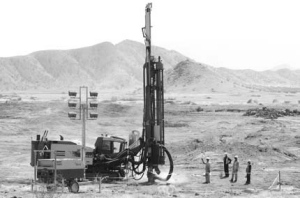VANCOUVER — Nevsun Resources (NSU-T, NSU-X) is now more than halfway through building Eritrea’s first mine, on schedule to commission the gold-silver-copper-zinc operation before the year end.
The company began prestrip mining in March at its Bisha project, which sits 250 km west of the capital Asmara. The prestrip is expected to take six month, as a hill adjacent to the deposit must be partially removed to make room for the open pit. Nevsun expects to start stockpiling ore early in the third quarter.
Installation of the semi-autogenous grinding (SAG) and ball mills should be finished by mid-year, structural steelwork is well advanced, and workers are laying down the impermeable liner of the tailings facility.
The Bisha mine will tap into a layered volcanogenic massive sulphide (VMS) deposit. The top layer, a gold-rich gossan, contains 4 million proven and probable tonnes grading 8 grams gold per tonne and 32.85 grams silver per tonne. Those reserves will feed a 5,000-tonne-per-day mill for 2.5 years.
Next, the mill will churn through a 6.4-million-tonne supergene layer grading 4.4% copper, 0.83 gram gold and 35.98 grams silver for 3 years. Finally, the mine will reach the primary sulphide portion of the deposit, which currently contains 9.7 million proven and probable tonnes grading 7.21% zinc, 1.14% copper, 0.76 gram gold and 54 grams silver.
The current mine plan only covers 10 years of operation but Nevsun is confident Bisha will be active for much longer than that. First, the pit was designed using very conservative metal prices, including US$400 per oz. gold. With prices currently more than double those used to build the pit shell, Nevsun is redesigning the pit to access the deeper, zinc-rich zone at the south end. An area known as the Hangingwall Copper zone will likely add resources to the expanded pit, reducing the increase in strip ratio.
And Nevsun has completed some infill drilling at Harena, a satellite zone 9.5 km southwest of the Bisha deposit, and further work is planned to assess its potential to provide additional mill feed for Bisha. In particular, the company is probing Harena’s southwest strike extension; the gravity and electromagnetic signatures that revealed mineralization at Harena continue to the southwest but have not yet been fully drill-tested. Nevsun also plans to drill other VMS targets on the Bisha property.
With Bisha’s cost requirements staying under control — in February, Nevsun revised the original capex projection of US$250 million up by just 4% to US$260 million — the company has managed to retain a cash position of $29 million. And Nevsun expects Bisha to start producing positive cash flow in the first quarter of 2011.
Using metal prices of US$900 per oz. gold, US$2.25 per lb. copper, US75¢ per lb. zinc, and US$12 per oz. silver, Bisha should generate a 45% internal rate of return, enabling payback of development costs in 1.6 years.
Nevsun’s share price recently peaked at $3.24. The company has a 52-week trading range of $3.00-$3.24 and 193 million shares outstanding.


Be the first to comment on "Nevsun pushes towards production in Eritrea (May 17, 2010)"